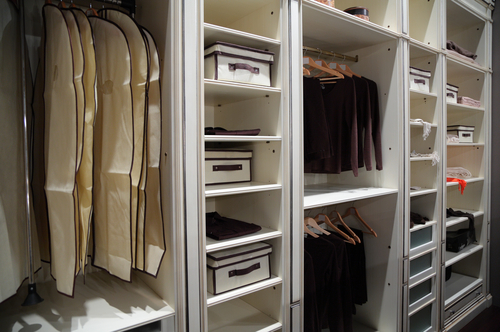Everyone has an organizing style. Knowing whether you are one or a combination of styles will help you capitalize on your strengths, mitigate your weaknesses and achieve the level of organization that best enhances your life.
Organizing Styles
HOBBYIST
Description: Hobbyists are often natural-born organizers, and for them, organizing is play. The nature of organizing makes it an ongoing process, but hobbyists are forever organizing and reorganizing because they want to—not necessarily because they have to. Hobbyists may or may not have magazine quality closets and pantries, but they tend to run a tight organizing ship. The downside? A hobbyist’s environment shifts often, which can confuse and frustrate other members of a household.
Guidance: Keep in mind that your constant shifting may be frustrating for members of your family, especially if you tend to concentrate your organizing projects in collectively used areas of your home. If you change up a much-used area, make sure to orient your family members to your changes. You will gain greater satisfaction from revamping areas and systems that are a bit more broken rather than constantly tweaking areas and systems that are working well. Also remember to take time to map your projects so you can make sure that you don’t mess up a smoothly functioning space or system in an organizing frenzy and then have to undo it shortly after.
CRAVER
Description: A craver loves the idea of having an organized space but has little to no idea how to achieve one. Cravers may have read all the books and attended all the organizing workshops but still find they have a little trouble putting two and two together. Cravers are highly motivated to live in an organized environment, and they are great at maintaining spaces and systems once they are set up. Because of a craver’s organizational tenacity, she will keep tackling organizing projects and will become more organizationally savvy through practice and sheer force of will.
Guidance: Don’t be too hard on yourself. Remember that only a small sliver of the population inherited the “organizing gene,” so you are in good company. Also remember that organizing is a learned skill, so you can and will get better at organizing as time goes on. If you find that you are stuck or getting overwhelmed with the level of organization in your home or office, enlist the help of an organizationally savvy friend or a professional organizer to help you establish well-organized spaces and simple systems that you can easily maintain. Make sure that you are involved in the process so you can learn some of the tricks of the trade.
AVOIDER*
Description: For an avoider, organizing is a necessary evil. Because virtually every organizing project from processing mail to clearing a closet is stressful, nothing gets done unless is absolutely has to. The problem is that by the time and avoider addresses a trouble spot, the scope of the disorganization is overwhelming, which feeds the avoidance cycle.
Guidance: As with any form of procrastination, you need to schedule time to take care of basic organizing tasks and commit to following the schedule. When you create a framework for completing your tasks, you put yourself in control of organizing projects rather than putting yourself at their mercy. You may also benefit from some organizing training, either from a friend who’s an organizing whiz or from a professional organizer. Once you know what you’re doing, you’re less likely to put off organizing until it hits critical mass and you’re consistently paying late fees, re-buying things you can’t find and drowning in paper.
PERFECTIONIST
Description: A perfectionist can appear at both ends of the organizing spectrum: total order or utter disarray.
Total Order
At the total order end of the organizing spectrum are those people who are motivated for any number of reasons to create utter organizational perfection. Their closets are worthy of photo shoots. They have menu plans and daily schedules. They go through spaces consistently to remove unwanted or unused items. Their houses are always clean. Total order perfectionists are compelled to have orderly environments. Disarray is distracting and distressing, and a total order perfectionist cannot function effectively or happily in clutter.
Utter Disarray
Perfectionists may reside at the utter disarray end of the spectrum as well. In a perfect world, beautifully arranged pantries and storage rooms are the order of the day, but since some perfectionists sense the enormity of the task, they choose to do nothing instead.
Guidance: Total order perfectionists, make sure you’re not so attached to creating the perfect environment that you neglect other important aspects of your life. Your organizing should support your life, not control it. You likely live with at least one other person who is as frustrated by your need for perfection as you are by their clutter. Remember that you really can be organized enough; soup can labels don’t always have to be pointing the same direction, and you can leave an occasional pile on the counter. That said, rejoice in your knack for putting and keeping it all together.
Utter disarray perfectionists, dream smaller! Take a walk through your environment and make a list of all the projects you’d like to tackle, then rate them in order of what irritates or impacts you most. Taking a more systematic approach will help you make progress toward what you really want while freeing you from feelings of overwhelm. And make sure you not only dream smaller, but start small as well. It’s much more motivating to experience organizing success on several small projects that to jump right in to a huge project like a garage or storage room.
SURFACE ORGANIZER
Description: Surface organizers are primarily concerned with what you see, not what you don’t. A surface organizer’s home or office may be the picture of perfection on the outside, so it’s hard to believe she feels so disorganized—until you open cupboards and drawers. Messes and broken systems seem to lurk behind nearly every closed door. Surface organizers often feel a great deal of guilt and embarrassment around their disorganization because it feels like a secret shame.
Guidance: Remember that those who appear organizationally perfect aren’t always; you are in good company. Be willing to take time out of a too-busy schedule to start small projects like the office supply drawer in the kitchen or your make-up drawer in the bathroom. Making your internal organizing systems consistent with the face you show the world will help you feel more powerful and in control.
FREE SPIRIT*
Description: Free spirits resist organization because they feel confined and trapped by the very thought. Free spirits would much rather spend time in creative projects and with people than organizing and putting away craft supplies, bills and laundry. A free spirit’s home can get out of control while she is involved in one of her many creative pursuits or while she participates in one of her many social engagements.
Guidance: A free spirit may benefit from a paradigm shift around organizing. Organizing is a platform to fly from—not to be tethered to. While a free spirit may not be able to tolerate a hobbyist’s or perfectionist’s organizing level, she needs a certain level of organization to support creative pursuits and social calendars. A free spirit would rather be doing most things besides organizing, which is what makes having some clear spaces and systems in place so important. Think of how much creative time you’ll gain if you don’t have to constantly look for project supplies and how much more time you’ll have to spend with friends and loved ones if you can find your keys and a matching pair of shoes.
SELF-SACRIFICER*
Description: A self-sacrificer spends most of her time creating order for others rather than for herself. While her children’s drawers and closets may be tidy, her own may be a scattered mess. While household paper may be under control, her purse is a dumping ground for everything from receipts to band-aids to empty food wrappers. Even if a self-sacrificer manages to begin a personal organizing project, she will abandon it at the first request from a family member or friend for help.
Guidance: Make sure you take time for yourself! If you find yourself constantly interrupted in your attempts to create order in areas of your life that really matter to you, practice setting some limits. If you are clearing out a drawer and your children need help finding a permission slip, make them wait for you to finish. The benefit to taking care of yourself is that you’ll have more to give your loved ones.
HOARDER
Description: Hoarders have gotten a lot of attention in the past several months. Who can forget Oprah’s special on hoarding and the disbelief at seeing 75 tons of trash coming out of an unassuming suburban home? Or what about A&E’s new series “Hoarders”? If you’ve seen anything on hoarding, you know it’s more than just basic disorganization. A hoarder literally cannot decide what items are important to keep and which can be tossed. Hoarders also tend to be compulsive acquirers, so stuff accumulates at an alarming rate.
Guidance: Hoarding has psychological roots, so simply trying to clear out your space is relatively ineffective in helping solve your organizing challenges. Aside from spatial intervention, you may also require some kind of psychological help. The National Study Group on Chronic Disorganization (NSGCD) is dedicated to helping hoarders and has a directory of professional organizers and other professionals trained to work with hoarders.
Here is an article about hoarders on www.oprah.com
Happy organizing!
Contact Kelly at:
www.spaceslimitedorganizing.com
or kelly@spaceslimitedorganizing.com
*These types where adapted from Ellen Welty’s Goodhousekeeping article “What’s Your Organizing Style?” www.goodhousekeeping.com















Add comment